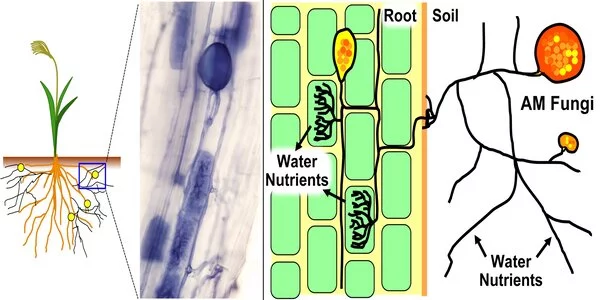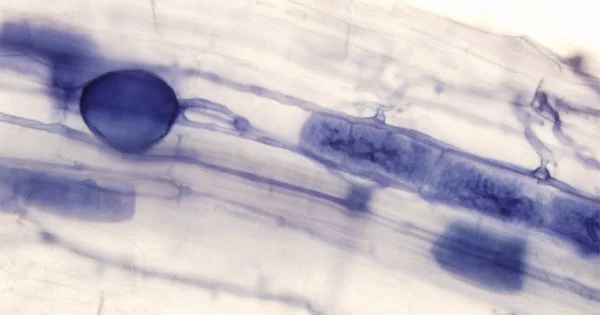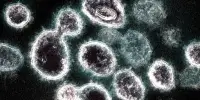Ancestral mitoviruses have been found in mycorrhizal fungi. Mitoviruses are viruses that infect mitochondria, which are energy-producing organelles found in all eukaryotic cells. Mycorrhizal fungi form symbiotic relationships with plant roots and play an important role in the nutrient exchange between plants and soil.
A new group of mitochondrial viruses restricted to the arbuscular mycorrhizal fungi Glomeromycotina may be an ancestral lineage of mitoviruses.
Mitochondria are organelles found in the cells of almost all eukaryotes (organisms with nuclei). They began as free-living bacteria capable of producing energy in the presence of oxygen before being engulfed by an ancestral eukaryotic cell and transforming into mitochondria, the site of cellular respiration and many important metabolic processes. In humans, mitochondrial dysfunction is linked to aging and a variety of diseases.
Bacteriophages are bacteria-infecting viruses. Mitoviruses, which evolved from bacteriophages, are viruses that infect mitochondria and were once bacteria. Mitoviruses have been discovered in fungi, plants, and invertebrates, but they have received little attention.
One of our most interesting discoveries is that the large duamitoviruses appear to be exclusive to glomeromycotina. We analysed the global distribution of all the mitovirus RdRp sequences included in our study, and we found that large duamitoviruses were globally distributed in ecological niches occupied by glomeromycotinian fungi.
Professor Luisa Lanfranco
Associate Professor Tatsuhiro Ezawa at Hokkaido University, Professor Luisa Lanfranco at University of Turin, and Dr. Massimo Turina at National Research Council of Italy (CNR) Torino led an international team to discover a new group of mitoviruses, called large duamitoviruses. Their findings were published in the journal mBio.
“In their current form, mitoviruses are RNA molecules within mitochondria that only encode the RNA-dependent RNA polymerase (RdRp) used for genome replication,” Ezawa explains. “It is hypothesized that they affect plant pathogen virulence and plant resilience to abiotic stress.” Most notably, mitoviruses are transmitted not only vertically to progeny through mitochondrial division, but also occasionally horizontally between distant species.”
The researchers looked at the RdRp enzyme in 10 new mitoviruses as well as sequences from previous studies and public databases. This study discovered the existence of unusual large duamitoviruses that are unique to the Glomeromycotina, a group of mycorrhizal fungi that are common in nature and provide numerous benefits to the host plants.

These large duamitoviruses have two structurally distinct features: they encode a larger-than-average RdRp (~1,036 amino acids long) with a unique amino acid motif, and the UGA codon is less common than in other mitoviruses. A phylogenetic analysis also revealed that the large duamitoviruses are evolutionarily distinct from other mitoviruses and most likely represent an ancestral lineage.
“One of our most interesting discoveries is that the large duamitoviruses appear to be exclusive to glomeromycotina,” Lanfranco described. “We analysed the global distribution of all the mitovirus RdRp sequences included in our study, and we found that large duamitoviruses were globally distributed in ecological niches occupied by glomeromycotinian fungi. Although other fungi are found in these niches, all currently available large duamitoviral sequences could be only associated with glomeromycotinian fungi.”
The researchers believe there is a transmission barrier that prevents large duamitoviruses from spreading horizontally. Future research will concentrate on elucidating these barriers, confirming that large duamitoviruses are an ancestral lineage of mitoviruses, and determining the functional significance of their exclusive presence in glomeromycotina.
















